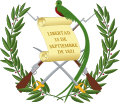| This article is part of a series on |
| Politics of Guatemala |
|---|
 |
Parliamentary elections were held in Guatemala on 16 December 1959, [1] in order to elect half the seats in Congress. Voter turnout was just 44.91%.
| This article is part of a series on |
| Politics of Guatemala |
|---|
 |
Parliamentary elections were held in Guatemala on 16 December 1959, [1] in order to elect half the seats in Congress. Voter turnout was just 44.91%.
| Party | Votes | % | Seats | |||||
|---|---|---|---|---|---|---|---|---|
| Won | Total | |||||||
| National Democratic Reconciliation Party | 78,763 | 25.81 | 25 | 35 | ||||
| Revolutionary Party | 71,682 | 23.49 | – | 7 | ||||
| National Democratic Movement | 67,615 | 22.16 | – | 13 | ||||
| Guatemalan Christian Democracy | 30,358 | 9.95 | – | 11 | ||||
| Revolutionary Unity Party | 21,173 | 6.94 | 0 | 0 | ||||
| Authentic Revolutionary Party | 14,158 | 4.64 | 0 | 0 | ||||
| National Renewal Party | 7,677 | 2.52 | 0 | 0 | ||||
| Guatemalan Anticommunist Liberal Party | 4,255 | 1.39 | 0 | 0 | ||||
| Institutional Reformist Party | 3,499 | 1.15 | 0 | 0 | ||||
| Anticommunist Authentic Party | 3,212 | 1.05 | 0 | 0 | ||||
| Party Nationalist Liberal Union | 2,734 | 0.90 | 0 | 0 | ||||
| Total | 305,126 | 100.00 | 33 | 66 | ||||
| Valid votes | 305,126 | 89.88 | ||||||
| Invalid/blank votes | 34,370 | 10.12 | ||||||
| Total votes | 339,496 | 100.00 | ||||||
| Registered voters/turnout | 756,000 | 44.91 | ||||||
| Source: Nohlen (votes) | ||||||||